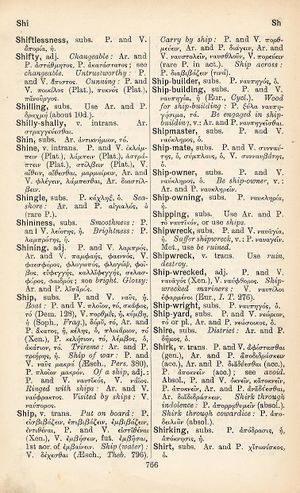shine: Difference between revisions
From LSJ
καὶ ἄλλως δὲ πολυειδῶς συζευγνύουσι τοῖς πράγµασι τὰ µαθήµατα, ὡς καὶ τῶν πραγµάτων ὁµοιοῦσθαι τοῖς µαθήµασι δυναµένων καὶ τῶν µαθηµάτων τοῖς πράγµασι φύσιν ἐχόντων ἀπεικάζεσθαι καὶ ἀµφοτέρων πρὸς ἄλληλα ἀνθοµοιουµένων → they couple mathematical objects to things in several other ways as well, since things can be assimilated to mathematical objects, and mathematical objects can by nature be likened to things, both being in a relation of mutual resemblance
(CSV5) |
m (Woodhouse1 replacement) |
||
| Line 1: | Line 1: | ||
{{Woodhouse1 | {{Woodhouse1 | ||
|Text=[[File:woodhouse_766.jpg|thumb|link={{filepath:woodhouse_766.jpg}}]] | |Text=[[File:woodhouse_766.jpg|thumb|link={{filepath:woodhouse_766.jpg}}]] | ||
===verb intransitive=== | |||
P. and V. ἐκλάμπειν ( | [[prose|P.]] and [[verse|V.]] [[ἐκλάμπειν]]; ([[Plato]]), [[λάμπειν]] ([[Plato]]), [[ἀστράπτειν]] ([[Plato]]), [[στίλβειν]] ([[Plato]]), [[verse|V.]] [[αἴθειν]], [[αἴθεσθαι]], [[μαρμαίρειν]], [[Aristophanes|Ar.]] and [[verse|V.]] [[φλέγειν]], [[λάμπεσθαι]], [[Aristophanes|Ar.]] [[διαστίλβειν]]. | ||
}} | }} | ||

